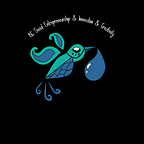Innovation Sense Making Den
Author: Barış (Grade 12)
Robert College Innovation Sense Making Den
RC Social Entrepreneurship, Innovation, and Creativity Office (RC SEIC) organized the very first meeting of the series “Innovation Sense Making Den”, during which faculty, staff, and students engaged in a discussion on Dr. Otto Scharmer’s Theory U with a particular focus on “transforming EGOsystems into ECOsystems”.
Why Innovation Sense Making Den?
The philosophy of “Innovation Sense Making Den” emerges from a critique of learning hierarchies, which divides the learning process into two distinct groups: students and teachers. This hierarchical structure results in missed learning opportunities. Our aim as RC SEIC Office is to flatten those learning hierarchies (#everyoneisalearner!) by creating a space for people from different age groups, roles, and backgrounds to meet and interact with, and learn from each other. To that end, in this series, we will be inviting faculty, staff, and students to sharing circles to consume content (a video/TED Talk/an article/a podcast) on (social) innovation and make sense of what we interact with together. We hope to hold space for the co-creation of a common understanding and shared language on (social) innovation and healthy conflict in this circle of diverse people bringing in different perspectives, knowledge, expertise, and experiences.
Meeting #1: Theory U by Dr. Otto Scharmer
We started off by watching a video of Systems Innovation Platform about the fundamental concepts behind Theory U. Then, to initiate the discussion part of the meeting, we asked participants to share their questions regarding the theory or specific points they would like to discuss:
- Can the higher self go back to the lower self?
- Does Otto Scharmer have any examples or organizations he has worked with that have gone through this process?
- How does one apply this process?
- How can we build a collective mind?
- Why is it so hard to transition from one mindset to another?
- What is the difference between the steps of enacting and embodying?
- To initiate a change/innovation, one should first notice a problem. In a post-truth world how can we even understand what the problem really is?
- What is the hardest stage to get through in the U graph?
What is Theory U?
Dr. Otto Scharmer explains Theory U as a process “showing how individuals, teams, organizations, and large systems can build the essential leadership capacities needed to address the root causes of today’s social, environmental, and spiritual challenges and how to update the operating code in our societal systems through a shift in consciousness from ego-system to eco-system awareness” {{Theory U}}. www.presencing.org/.
How do we apply this process? How to move along the U
“The U: One Process, Five Movements.” Presencing Institute, www.presencing.org/aboutus/theory-u.
As we explored each step of the process, as a community we witnessed the emergence of rather unexpected questions.
How can we build a collective mind? How should we listen to others?
In order to build a collective mind, deep listening is an essential. According to Dr. Otto Scharmer, there are 4 types of listening one can observe in daily life, and these determine the quality of every interaction.
“4 Levels of Listening.” Community Organisers, 18 Dec. 2019, www.corganisers.org.uk/news-blogs-and-events/4-listening-levels/.
- Level 1 refers to the habit of listening to only reconfirm one’s pre-existing ideas. This level of listening prevents effective learning.
- Level 2 is the act of noticing that there might be a new and a different idea.
- Level 3 is using the lens of empathy while listening and being able to see the concept through others’ perspectives.
- Level 4 is basically shaping each other during the interaction. It includes unlearning and relearning.
Listening each other with an open mind, open heart, and open will might help us form a culture of innovation in our school environment. During this process, every member of the community should bend the beam of observation from out there to one’s own self, and consequently start the process of change at an individual level.
At the end of the event, we asked our community members to share their insights, opinions, and questions regarding Theory U and the experience of Innovation Sense Making Den.
- I think I ended up with even more questions. For example, how do we build a collective mind from the bottom up or the top down or both?
- So much to learn; so many intriguing ideas; so much to reflect on and GET BETTER AT.
- Even though we are aiming to make change, we should first learn to be open-minded in order to make that conversion durable.
- People need to go out of their comfort zones and put profit under some important values like empathy.
- I need to observe the world through myself, because I am a part of the world not apart from it.
- This session made me question my own actions. I now feel the burden of knowledge and am now obliged to use this knowledge for the better!😎
- I think the idea of flattening learning hierarchies will revolutionize the science world. I am actually upset that there has probably been a wasted potential. We could’ve achieved a lot more.
- Really nice ideas, questions, and concerns :) I like it. Many thanks for trying to be together. “Open heart, open mind, and open will!”
Resources to Deep Dive
- Who is Otto Scharmer?
- Presencing Institute, co-founded by Dr. Otto Scharmer
- Theory U, Leading From the Future As It Emerges
- Presence: Human Purpose and the Field of the Future
Invitation
How do you bend the beam of observation from the system (out there) to yourself? Share your comments and questions with us.
